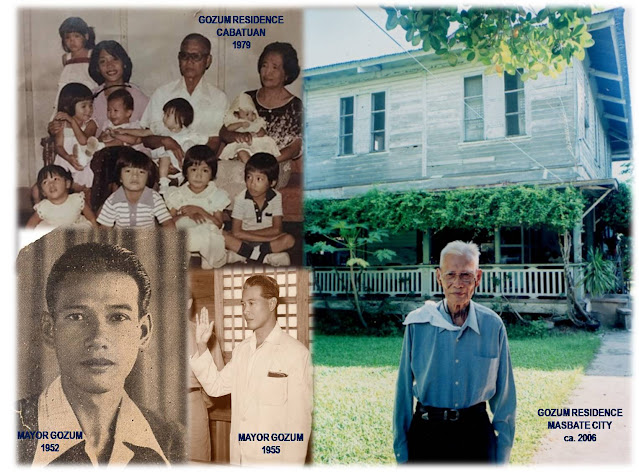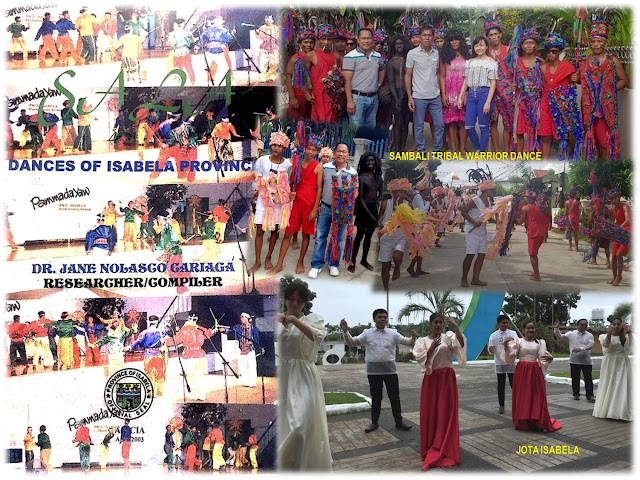122. TATANG PAENG, THE 1ST ELECTED MAYOR OF CABATUAN
TATANG PAENG, THE 1ST
ELECTED MAYOR OF CABATUAN
Dr. Troy Alexander G. Miano
24
October 2020
Tatang, as all his children, grandchildren and
great grandchildren fondly called him, should have celebrated this day his
hundred and one years on earth; however, thirteen years ago, he joined our
Creator on July 24, 2007.
Tatang was born as Rafael Maniego Gozum on
October 24, 1919 at Grace Park, Kalookan, Rizal (now Caloocan City) to Leoncio
Cortez Gozum (1885-1957) and Rosa Lobo Maniego (1883-1975). The sixth in a
brood of eleven, he was baptized the following day at the historic San Roque
Catholic Church, now the Caloocan Cathedral.
A detailed genealogy of Tatang shows that
Leoncio was the son of Mateo Gozum and Nicolasa Cortez (1850-1956) while Rosa
Maniego was the daughter of Martina Lobo. Mateo Gozum, on the other hand, was
the son of Pedro Gozum while Nicolasa Cortez was the daughter of Venancia
Suñga. According to oral narrations, Rosa Maniego’s ancestor was Don Francisco
Maniago of Mexico, Pampanga, leader of the Maniago Revolt in 1660. The revolt
was the product of the natives protest against the polo y bandala (forced labor
and tribute). A bust of Francisco Maniago is part of the Heroes Gallery in
Rizal Park in Manila. The surname Maniego is a deviation of Maniago and so with
Gozum and Gozum.
Stories handed from generation to generation
narrates that Pedro was a pure Chinese from Amoy (now Xiamen), China bearing
the name Zun Go. After migration, he adopted a common Filipino name which was
Pedro and immortalized his original name by using it as his surname – Gozun.
There were no data on the details of his wife; his son, Mateo, however further
improved the surname and changed the last letter to “M” for a more phonetic
harmony. Venancia Suñga, on the other hand, had a street named in her honor in
the town center of Apalit, Pampanga for her philanthropic deeds.
The Mateo Gozum lineage hailed from Macabebe, Pampanga. They transferred to Kalookan and Malabon area in Rizal province at the outskirt of Manila at the turn of the century. The couple migrated to Bicol particularly in Sorsogon when one of his sons, Leocadio, was stationed at the combined provinces of Sorsogon and Masbate. Leocadio later married Engracia Buencamino Zurbito, the daughter of the 9th Governor of Sorsogon Don Jose Zurbito, and settled in Masbate, Masbate in 1932. Tatang, nicknamed Paeng, stayed with his uncle in Masbate until he reached high school. Leocadio was reassigned in Isabela province as the 2nd provincial auditor from June 25, 1938 to February 24, 1940. With this, the Mateo Gozum clan migrated for the third time and the family permanently settled in the capital town of Ilagan. Another son of Mateo, Patricio, the older brother of Leocadio, was also assigned in Isabela as Assistant Superintendent of Schools. The youngest child of Patricio, Alfredo, in his memoirs, narrated that his father was one of the few invited by Don Lino Castillejo, Governor of Isabela, to take the plane for Manila at the outbreak of the Japanese Occupation of the valley in 1942.
Tatang came to Isabela from Masbate before the Second World War and studied units in accounting at the Isabela School of Arts and Trades (founded in 1908) in Ilagan and was employed in 1939 at the newly inaugurated municipality of Cordon as principal clerk, an equivalent to present-day Assistant Municipal Treasurer, under the mayorship of Mayor Angel Batoon. In this gateway town, he settled and married Concepcion Aquino Lorenzo (1918-1945) on July 3, 1940 and their union was blessed with two children, namely: Librada (1941) and Renato (1942). During World War II, the couple evacuated to Jones, Isabela, the temporary capital of the province. Here, Concepcion or Conching died of malaria in May of 1945 together with the stillborn baby who was named Roque. After Liberation, the two kids of Rafael were taken care of by her first degree cousin Florencia “Enchang” Maniego-Layugan (daughter of Antonio, brother of Rosa who was the mother of Tatang) and husband Manuel “Maning” Layugan who worked as a kapatas or foreman at the Department of Public Works and Communication (DPWC) and was assigned in the Cabatuan area.
Tatang, already 26 years old, met Nanang in Barrio Cabatuan particularly at the market place in what is now the Bonifacio Park in Barangay San Andres. Tatang visited the area, together with his uncle Patricio, to see Enchang and Maning. The 31 year-old Nanang, born Marciana Borromeo Ramos, was the daughter of one of the founders of Cabatuan, Feliciano Agustin Ramos and Juliana Dela Cruz Borromeo. Tatang started his series of love letters which were answered by Nanang from January 31 up to June 23, 1946, twelve days before they got married. A total of 19 letters were preserved for over seven decades and is now compiled in the book entitled; “Post War Love Letters, circa 1946”. After their union on July 6, 1946, Tatang moved to Cabatuan and erected a house along the main road in what is now Barangay Saranay with his older brother Quirino as the foreman. The residence is now known as the Historic Gozum Ancestral House. The union of Tatang and Nanang was blessed with six children, namely: Victor (1947), Liliosa (1948), Sylvia (1950), Amelia Flor (1952), Rafael Mateo, Jr. (1954) and Milagros Andrea (1959). Tatang was re-assigned at the municipal government of Aurora, Isabela as principal clerk since it was closer to Cabatuan than Cordon.
During the conceptualization of Barrio Cabatuan to be segregated from the mother-town of Cauayan and to be converted into a town, Tatang, together with the leaders of Cabatuan regularly met at the house of his sister-in-law Nicanora and husband Damian S. Tomacruz in the old poblacion. On November 5, 1949, President Elpidio Quirino signed Executive Order No. 293 creating Cabatuan and its adjacent barrios into a regular municipality in the presence of the official Cabatuan delegation headed by the settlement’s founder, Don Bernardo C. Dacuycuy. On November 30 of the same year, Feast of Saint Andrew the Apostle - the barrio’s patron, Cabatuan was inaugurated and functioned as an institution on January 1, 1950. Since the new town has no town hall yet, Tatang and Nanang offered their residence, free of charge, as the temporary seat of the municipal government until June of the same year.
Tatang was again re-assigned as principal
clerk in the new munisipyo until he resigned to file his certificate of
candidacy in the first elections on November 1, 1951. He won as the first
elected mayor of Cabatuan and the youngest so far at the of 32. He was
eventually reelected in the November 8, 1955 local polls. The Gozum
administration continued the reorganization of his predecessor and created additional
barrios for the newly minted town. Various infrastructure projects including
road opening and rehabilitation, construction of municipal auditorium and
erection of bailey bridges were implemented. Worth mentioning was the execution
of the deed of donation for the municipal grounds and the construction of the
first concrete municipal town hall which was inaugurated at the start of his
second term. Old folks would recall that during Tatang’s term, Cabatuan
experienced very festive civic and town fiestas.
Tatang lost his reelection bid for a third term together with the whole Nacionalista Party slate. Gentleman as he can be, Tatang graced the inauguration of the newly elected officials and turned over the cane of authority to the coming back town head. His retirement in politics paved way for his return as an employee of the government in 1960. He served at the Bureau of Internal Revenue (BIR) and was stationed at Cauayan, Reina Mercedes and Cabatuan until his retirement on his birthday in 1984. His stint at the BIR earned for him a reputation of being able to convince big time individuals and companies including high profile politicians to pay their obligations to the government.
After the People Power Revolution of 1986, OICs (Officer-in-Charge) were appointed to local posts. To facilitate the first free elections of the new government, another set of OICs were appointed and Tatang assumed his old post as municipal mayor of Cabatuan and served from December 6, 1987 to February 5, 1988.
Tatang lost his reelection bid for a third term together with the whole Nacionalista Party slate. Gentleman as he can be, Tatang graced the inauguration of the newly elected officials and turned over the cane of authority to the coming back town head. His retirement in politics paved way for his return as an employee of the government in 1960. He served at the Bureau of Internal Revenue (BIR) and was stationed at Cauayan, Reina Mercedes and Cabatuan until his retirement on his birthday in 1984. His stint at the BIR earned for him a reputation of being able to convince big time individuals and companies including high profile politicians to pay their obligations to the government.
After the People Power Revolution of 1986, OICs (Officer-in-Charge) were appointed to local posts. To facilitate the first free elections of the new government, another set of OICs were appointed and Tatang assumed his old post as municipal mayor of Cabatuan and served from December 6, 1987 to February 5, 1988.
Tatang devoted most of his retirement years
cooking, gardening and visiting his children and grandchildren in the
metropolis. Together with Nanang, they tried their best to grace the graduation
rites and birthday celebrations of their descendants.
After 66 years, Tatang who is already 86 years old went back to his dear Masbate at No. 3 Mabini Street, Masbate City in the Bicol region. This journey brought back numerous memories of his teenage years. He remembered his childhood friends and classmates who most of them had already moved to the great beyond and are now remembered through street names and even a name of a municipality in southern Masbate.
In 2007, Tatang joined Nanang who died three years earlier on June 13, 2004. Tatang is known in Cabatuan as a public servant who did not enrich himself during his mayorship and his service at the BIR. This legacy of clean public service benefitted his children and grandchildren who later entered politics. Tatang Paeng, the first elected and youngest mayor of Cabatuan, is a public servant par excellence not only in the eyes of his family and friends but to the common Cabatuanenses.
After 66 years, Tatang who is already 86 years old went back to his dear Masbate at No. 3 Mabini Street, Masbate City in the Bicol region. This journey brought back numerous memories of his teenage years. He remembered his childhood friends and classmates who most of them had already moved to the great beyond and are now remembered through street names and even a name of a municipality in southern Masbate.
In 2007, Tatang joined Nanang who died three years earlier on June 13, 2004. Tatang is known in Cabatuan as a public servant who did not enrich himself during his mayorship and his service at the BIR. This legacy of clean public service benefitted his children and grandchildren who later entered politics. Tatang Paeng, the first elected and youngest mayor of Cabatuan, is a public servant par excellence not only in the eyes of his family and friends but to the common Cabatuanenses.




Mga Komento
Mag-post ng isang Komento